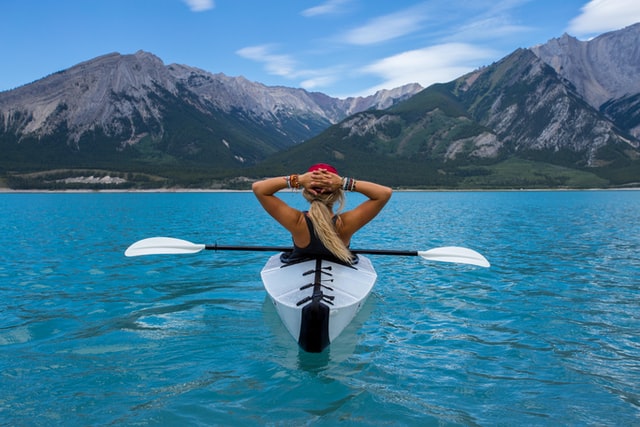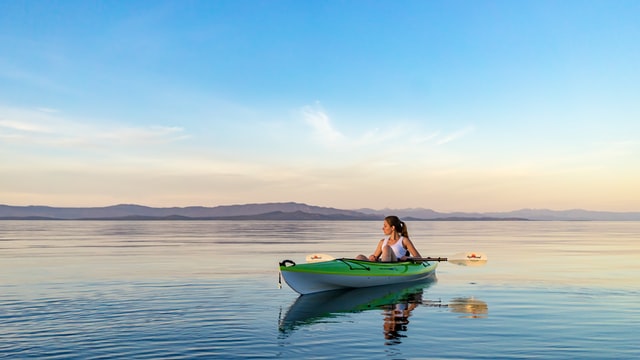Choosing the right kayak is much like choosing a car. Different budgets, features, and qualities vary from model to model. Nonetheless, by understanding what you want to get out of it, you will be better positioned to choose one that perfectly fits your needs. This can be especially true for those looking to lose weight in a healthy and fun way but are unsure if kayaking is the right option. The short answer is that kayaking is perfect for those with a few extra pounds, and you will be pleasantly surprised at how much fun you can have while losing weight simultaneously with kayaking. This post will cover the general questions you should ask yourself before spending your hard-earned money to give you the greatest chance of success in your purchase.
Vagabondish is reader-supported. When you buy through links on our site, we may earn a small affiliate commission. Read our disclosure.
How Much Weight Capacity You Need
As mentioned in the introduction, kayaking is a fantastic way to lose weight in a fun way. Taking a tour of the lakes and rivers in your vicinity will result in you losing weight gradually without even realizing it! However, most kayaks will have a weight limit they can handle. If you are worried about being too heavy, you need not fret. There are plenty of options available to you, and you might want to choose something like a 500 pound weight bearing kayak. While you might not be that heavy, you will need the extra capacity if you will use it to carry your belongings with you when doing something like a kayak camp adventure, etc. Essentially, it is prudent to buy a kayak with a higher weight capacity to be prepared for any eventuality.

Consider What Activities You Would Like To Do
Kayaks come in a broad range of styles and designs, each tailored towards a different activity. Your general types are great for those looking to break it out on the river once a month, and more specific options like competition options are designed for speed. Therefore, your first considerations should be what you want to do. The different types include:
- Recreational: This is your all-rounder. You can use it for almost anything you throw at it, but you should think of it as a Jack of all trade but master of none. Nevertheless, despite that moniker, they are brilliant options for those just getting started (not to mention affordable).
- Crossover: These are usually a mixture of two styles that combine the best of both worlds. You won’t find truly crazy crossovers, but they will typically mix recreational and something else. Great if you want to try other kayaking options but don’t want to commit to a specially-designed hull.
- Touring: These can be split further into day and multi-day touring kayaks. They usually have some form of rudder and lots of space to store your touring gear. However, they are also heavier, bulkier, and generally more difficult to keep since they are designed for long-term travel.
- Inflatable: This is precisely what it sounds like! Inflatable kayaks are great for those who kayak occasionally and allow you to store and transport them effortlessly.
- Sea: Sea kayaks are designed to rescue the impact from waves and have a high degree of control.
- Whitewater: If you are looking for a rugged kayak, a whitewater option might be a perfect choice. They have wide hulls and are designed to withstand the rigors of this activity.
- Folding: A folding kayak offers the portability of an inflatable one but with the strength of a regular one. However, they can be costly.
- Fishing: These typically have wide hulls for increased stability and many places to store fishing equipment. They are only helpful for those who enjoy fishing.
Will You Ride Alone Or Tandem?
If you are traveling with a companion, you might opt for a tandem. Conversely, if you are a lone soul who wishes to explore the great outdoors with nothing else but your thoughts, a single-seater will be your best bet. However, if you have kids or want to experience your adventure with a loved one, there is nothing quite like a tandem kayak to share your journey with. Remember that tandems are much costlier than their single-seater counterparts.
Do You Want To Sit On Or Sit In?
The last thing you need to decide is if you want to sit in or sit on your kayak. A sit-in will provide you with great comfort, control, and carrying capacity but will also make it more challenging if you capsize. On the other hand, sit-on kayaks are quick and easy to get on and fun for a brief stint in the water. But the major downside is that you will probably get wet, and you sacrifice a certain level of comfort.
Choosing a kayak can be challenging, especially if you have never done it before. However, with such a plethora of options available, there is something for everyone. Whether you are overweight and looking for a fun activity to become more trim, or a fisherman wanting an affordable way to fish in deeper waters, every taste can be satisfied.


